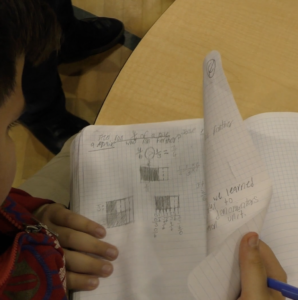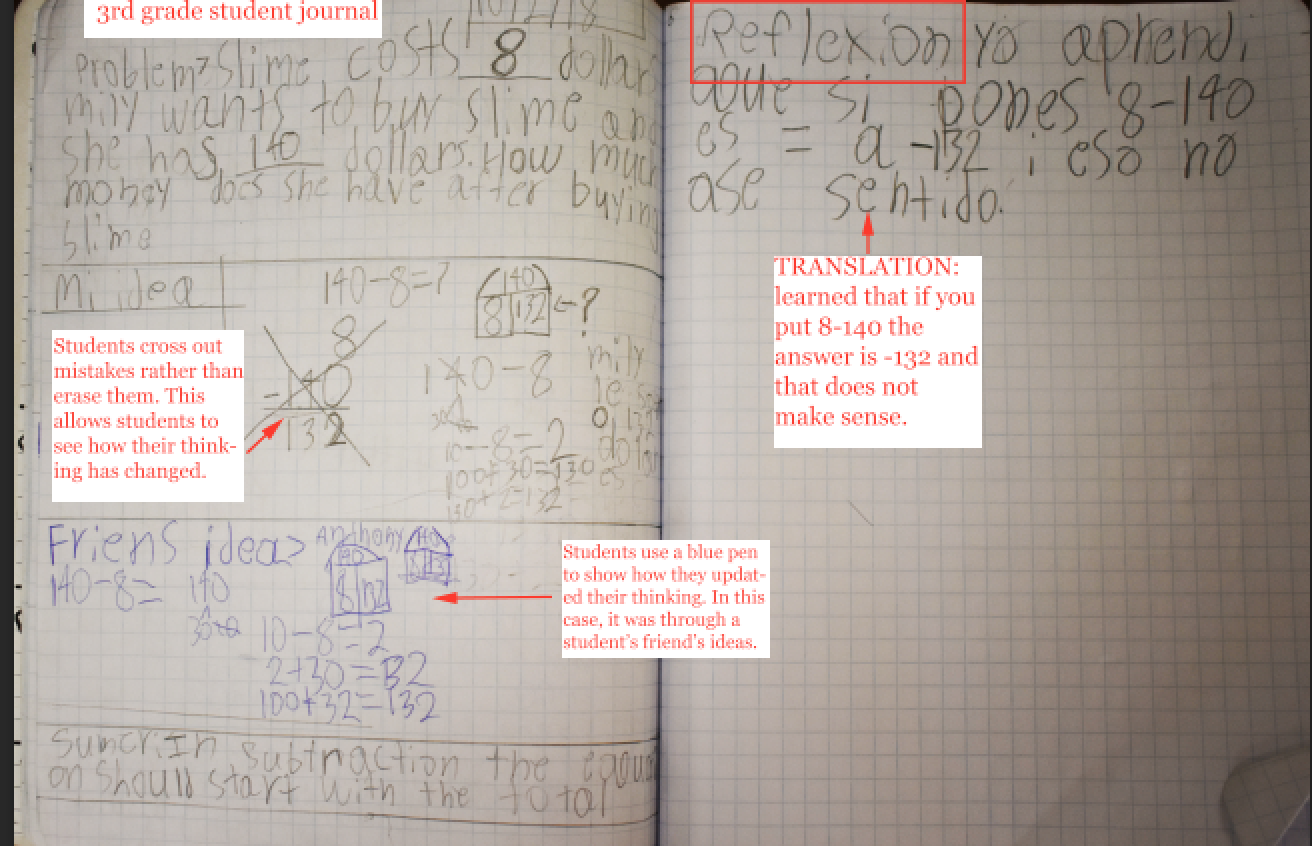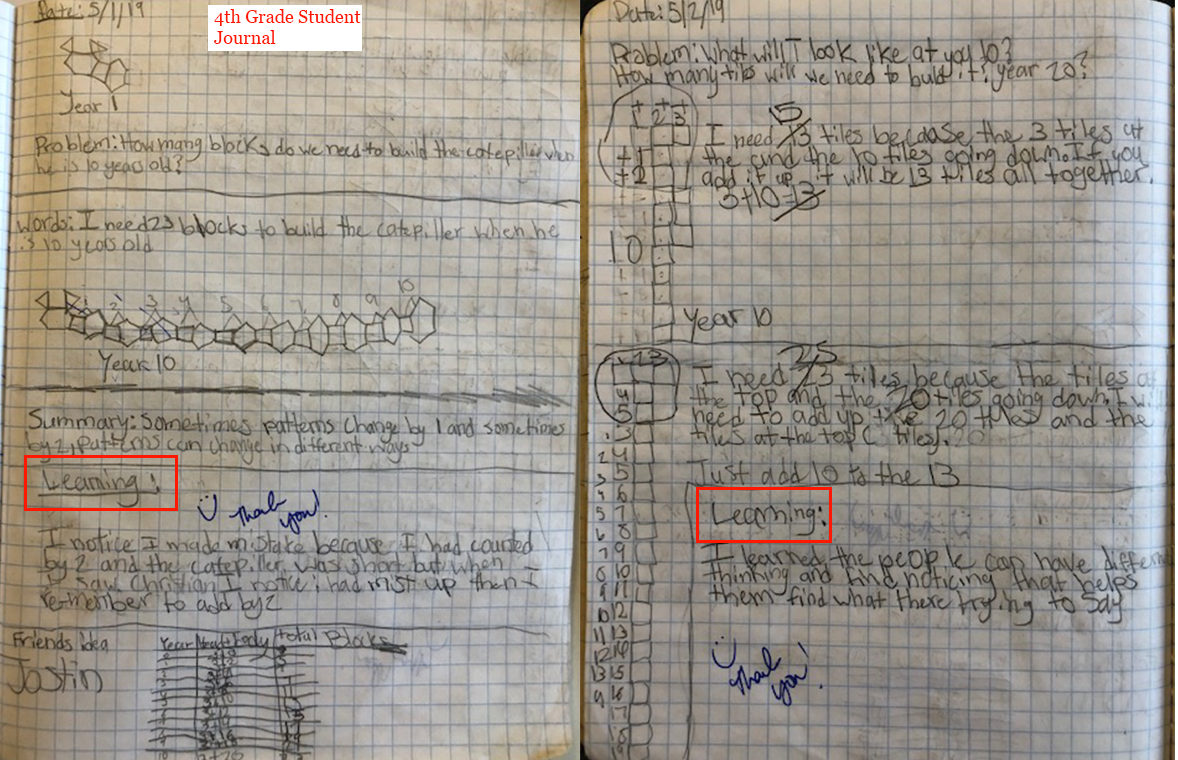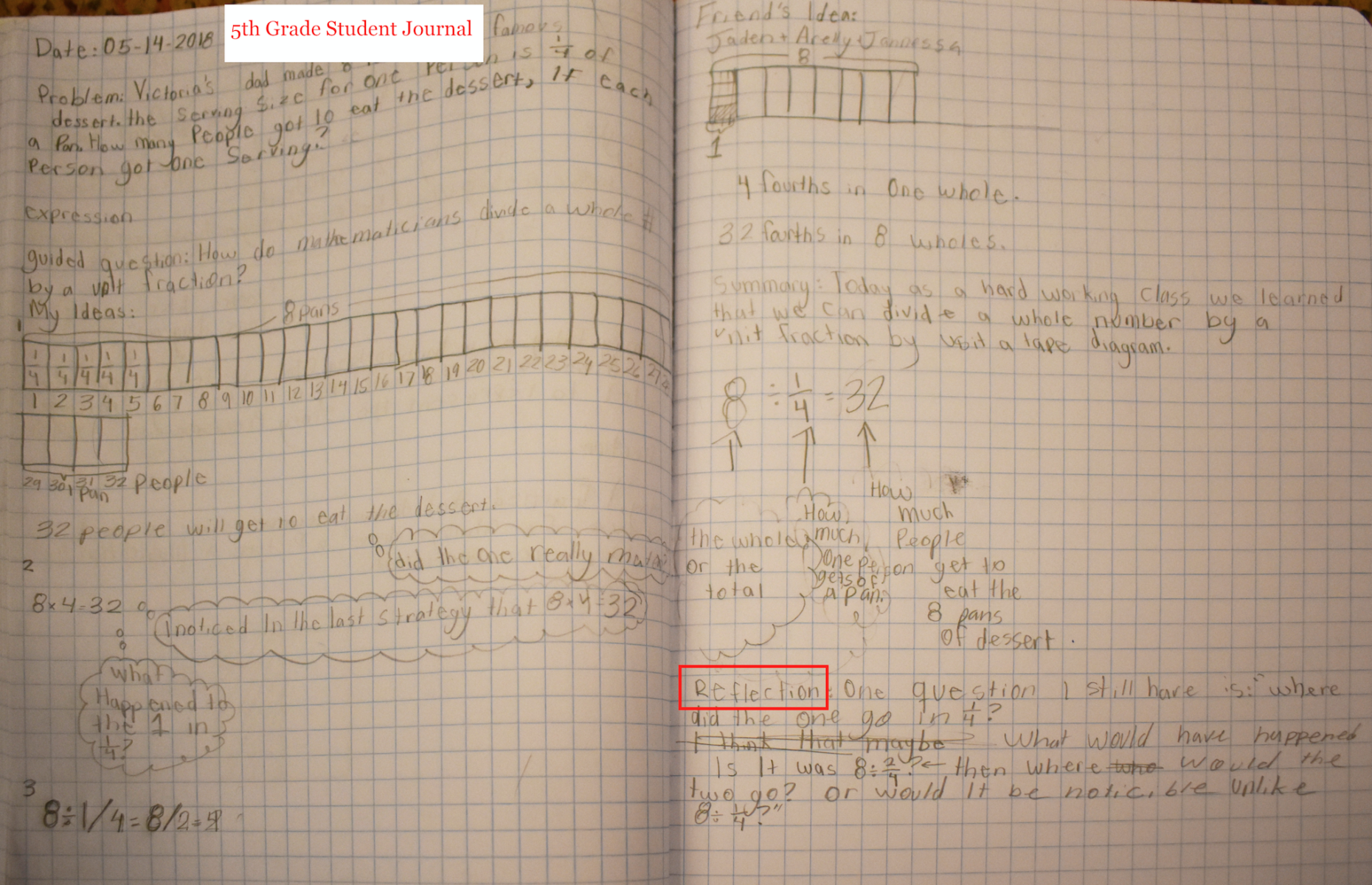This course for K-6 educators explores the power of student reflective journals in building students’ mathematical knowledge and practices.

Session 1: Explore the Inquiry Topic & Reflect on Your Current Practice
Outside-of-class meeting | Time: 1 hour | Materials: Recent Student Journals (class set) and board photographs for several recent lessons
Focus
Journals can be a powerful place for students to build productive mathematical mindsets. For example, as students look back on the learning over time represented in their journals, they can see that their careful effort has built their mathematical knowledge. They can build interest in mathematics as they learn from classmates’ ideas and notice unexpected strategies from classmates. They can build agency as they see how their own thinking is used and referenced by classmates. Students realize that they now understand ideas that they initially did not understand, sparking their willingness to persevere when they hit a puzzling idea in the future. Likewise, they notice that problems can be solved in many different ways, sparking curiosity about whether there are even more solution methods.
1A: Reflect on Your Current Practice
- Review your students’ journals. What kinds of evidence in these journals suggests that students are building important mathematical mindsets such as agency, perseverance, and curiosity? What kinds of additional evidence would you like to see in students’ journals in the future?
- Reflect on current practice. Consider how you currently use journals to build students’ productive mathematical mindsets such as agency, perseverance and curiosity.
1B: Learn about New Strategies
Some educators recommend the following strategies for using journals to build mathematical agency, perseverance and curiosity.
- Begin each class by showing several students’ journal reflections from the prior lesson. (These can be posted on the board, printed and handed out, and/or shown on an overhead). In addition to highlighting the big mathematical ideas from the prior lesson, these reflections can highlight productive mindsets you are working to build in your classroom. For example, a reflection might show how a student learned from their mistakes, persevered, or wondered about a mathematical idea. Look at the journal reflection examples in the slider below and consider why teachers may have chosen these to read aloud at the beginning of the next class.
- Look at the journal reflection examples in the slider below and consider why teachers may have chosen these to read aloud at the beginning of the next class.
- Use prompts or sentence frames that support the mindsets you are working to nurture, for example:
- Something I am still wondering about is….
- Next in math, I would like to learn about…
- A friend’s idea I would like to try is...
- Provide opportunities for students to self-assess their journal writing, such as to
- Choose one thing they’d like to improve in their journal writing, work on it for 3-5 entries, and then self-assess whether they have improved. Based on how satisfied they are, keep working on it or choose a new thing to work on
- Find a journal entry they are particularly proud of and show it to a classmate or family member
- Find a problem in their journal that was really hard when they first saw it, but now they understand it
1C: Plan to Try New Strategies
- Identify one or more strategies you will try in your classroom to use journals to build students’ mathematical agency, perseverance, and curiosity.
- Identify evidence will you look for in journals, reflections shared or other aspects of classroom instruction to inform you about the impact of the strategies.
Session 2: Try New Strategies in Your Classroom
In class | Time: 3-5 lessons over 1 to 2 weeks
- Try out the strategies in your plan for approximately 3-5 lessons in which journals are being used
- Keep a record of what you did, such as the reflections you used to start each lesson, and jot down notes during or soon after each lesson to capture your experiences with the strategies that you tried
- Bring your notes and the class set of students’ journals to the next session
Session 3: Examine Evidence and Refine Your Plan
Outside-of-class meeting | Time: 30-60 minutes
3A: Examine Evidence from Lessons and Revise Plan
Examine student journal entries and your notes. Reflect on the following questions (followed by group discussion, if working with a team):
- What do you notice in the student journals, with respect to important mathematical mindsets such as agency, perseverance and curiosity? What changes are there, if any, since the last time you examined journals for these mindsets?
- What strategies were successful, and what did you find challenging, as you tried to build students’ mathematical mindsets?
- What strategies would you like to carry with you in your next week of instruction and what refinements, if any, might you make, to enhance benefits to your students?
- What new strategy(ies) would you like to test our in the next week?
3B: Make a Plan for Your Second Round
- Identify new or refined strategies you will try in the next 3-5 lessons to improve board use and the connection between board and journals
- Identify the evidence will you look for to help you assess the impact of your work
Session 5: Examine Evidence and Reflect on this Inquiry Cycle
Outside-of-class meeting | Time: 30-60 minutes
5A: Examine Evidence and Reflect
Examine student journals and your notes. Reflect on the following questions, followed by discussion (if working in a team):
- What do you notice in the student journals, with respect to important mathematical mindsets such as agency, perseverance and curiosity? What changes are there, if any, since the last time you examined journals for these mindsets?
- What strategies were successful, and what did you find challenging, as you tried to build students’ mathematical mindsets?
- What strategies would you like to carry with you future instruction?
- What new strategy(ies) would you like to test out?
5B. Reflect on this Inquiry Cycle
- What did you learn that might inform future inquiries–for example, how to collect data, collaborate, find useful resources, etc.
- Is there anything from this inquiry you would like to share more broadly at your school or with the profession? How will you do this?
Session 4: Test Your Refined Approach
In class | Time: 3-5 lessons over 1 to 2 weeks
- Try out the strategies for approximately 3-5 lessons in which journals are being used (about 1-2 weeks)
- Keep a record of what you did, such as the reflections you used to start each lesson, and jot down notes during or soon after each lesson to capture your experiences and observations related to the strategies that you tried
- Bring your notes and your students’ journals (class set) to the next session




